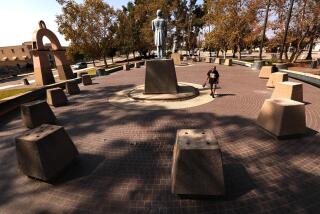Seeing the Parthenon--In Athens and in London : Dispute Continues Between Greece, England Over Ownership of Elgin Marbles
- Share via
ATHENS — Like Greece itself, this ancient city’s Parthenon has been a victim of history--occupied, plundered and defiled by invaders over the centuries from the Christian crusaders to Ottoman warriors to the swastika-bannered Nazis.
Originally a sacred shrine to the goddess Athena, the great temple atop Athens’ Acropolis has suffered from vandals, treasure hunters, cannon balls and smog.
But none of the ravages of war and time continue to haunt Athenians like the damage done to the Parthenon nearly two centuries ago by a British ambassador--Lord Elgin of Scotland--who at the time endeavored to fill his luxurious new manor with marble knickknacks fit for the gods. Greek gods.
Lord Elgin’s wholesale transfer of priceless Parthenon sculptures and carvings--what was arguably one of history’s most infamous home improvement projects--not only soured relations between generations of Greeks and British but also complicated the travel plans of tourists ever since.
Thanks to that 19th Century ambassador, a tour today of the Parthenon in Athens cannot be completed without riding a winged chariot to London and the British Museum.
In 1801 Elgin used his silver tongue and silver purse to entice the occupying Turks to let him dismantle much of the Parthenon’s elaborate stonework. Before the bribe money ran out, he had carted off to the British Isles boatloads of marble art, much of it on British warships.
Controversy Over Marbles
Thus were born the “Elgin Marbles” and a historic controversy surrounding rightful ownership of the Parthenon’s treasures.
Over time the antagonists have changed: divorce and other financial setbacks eventually forced Elgin to sell the marbles (at garage sale prices) to the British Museum, and the Turks finally were forced out of Athens. But the controversy remains.
Today, more than ever, Athenians want the Elgin Marbles returned. These symbols of Greek glory, they argue, belong on the Acropolis, not the Thames.
Tourists who make the side trip to London know, however, that whether in flourescent-lighted museum halls or bathed in Grecian sunshine, the Parthenon, even in scattered ruins, remains everything that Pericles boasted it was millenniums ago:
“Mighty indeed are the marks and monuments of our empire,” the Athenian leader said upon its completion. “Future ages will wonder at us, as the present age wonders at us now.”
As well-traveled tourists know, the Acropolis is minutes by taxi or bus from anywhere in central Athens. Most of its 3 million annual visitors arrive in some motorized conveyance. But somehow it doesn’t seem appropriate to rush from a vehicle of the 20th Century AD to a shrine of the 5th Century BC without so much as a pause to contemplate the time change.
The adjacent Areopagos, also known as Mars Hill, is just the place for that pause. The ascent is up marble steps chiseled into the hill, slick as ice, polished by centuries of sandals. No need for the miracle of a time machine here. Even on a smoggy day the view is forever--from modern Athens to ancient Greece.
This summit is the venue of Panos, a local tour guide. For about $5 he’ll show visitors the very spot where Pericles declared Athenian democracy, where Socrates was condemned, where the apostle Paul preached the first Christian sermon to the West. All of this on a barren hilltop not much bigger than a couple of tennis courts.
When he’s finished, Panos sends his clients on to the Acropolis properly briefed for the tour--and properly forewarned.
“Sadly, the temple is not all there. You won’t see the half of it. The British, they stole the rest,” he said, soliciting a small monetary sacrifice for the national restoration effort.
From Mars Hill the climb to the Acropolis summit follows the final steps of the Panathenaic Way. In the days of Pericles, this was the path of the Grand Procession that once every four years was followed by Athenian pilgrims bearing gifts and sacrifices for Athena.
Finally, up broad stone steps and winding ramps the route approaches the Sacred Way atop the Acropolis. And there it waits, towering above the rocky plain: The Parthenon, a monument bigger than history.
A Parthenon tour today follows the same course as the ancient processions, beginning at the west end and continuing around the temple perimeter along the north side toward its traditional front, the eastern facade.
The massive and distinctive columns are still there, but gone are virtually all of the marble gods that once filled the east and west pediments. Of the 37 original sculptures, only three remain on the Parthenon. Lord Elgin removed 20 of them, nine are missing and presumed destroyed and five are in the Acropolis Museum.
The metopes, panels of marble carvings that trim all four sides of the temple, posed a difficult demolition problem for Elgin and his crew, which may have saved them. Most remain in position, still crowning the Parthenon ruins--except along the south side where Elgin broke off 15 panels depicting the epic battle between the Lapiths and the mythical Centaurs.
The final decorative element trimming the temple, the frieze, is an immense band of marble carvings about 3 feet high and 525 feet long. It is believed that its 111 panels depict the Grand Procession, with figures of the 192 men and boys who died fighting the Persians at Marathon. Most of the panels were removed by Elgin.
To Athenians, the visual effect is as if someone had scrawled “Elgin Was Here” all over the Parthenon.
Remarkably, the Parthenon did quite well without anyone’s protection for its first 2,000 years. While in the hands of the Romans it was unharmed. Even German barbarians didn’t abuse it. After 900 years Christians did a little remodeling, adding a bell tower and changing the entrance from the east to the west, for example. After another 900 years the Turks removed the Christian touches and added a minaret.
In 1687, with the Turks using the Parthenon as a munitions armory, ruin came with a Venetian grenade that ignited a pile of gunpowder. The center of the temple was destroyed, the roof blown off and many of the carvings smashed or damaged. It would never fully recover.
But there is fresh hope. Signs of restoration are everywhere. Pieces of numbered and catalogued sculpture are stored just outside the temple, waiting to be remounted. Scaffolding climbs the walls and columns. The beam of a massive crane sticks out from between the pillars.
Work on the Parthenon began five years ago and is scheduled for completion by 1995. Pressure is mounting to make return of the Elgin Marbles a part of that restoration effort. Greeks, it’s clear, don’t want to go to London to see the Parthenon.
Since the early 1980s, actress Melina Mercouri, a member of the Greek parliament and former minister of culture, has been a passionate leader of the campaign to persuade British authorities to return the marbles. As part of that campaign, she advocates construction of a new Acropolis Museum with a grand exhibition hall--to remain absolutely empty until the Elgin Marbles come home.
Returned to Greece
And more recently, in his finely detailed book “Imperial Spoils: The Curious Case of the Elgin Marbles” (Hill & Wang), British-born author Christopher Hitchens also argues that the marbles should be returned to Greece.
“It will make a visit to the Acropolis the vision that it should be,” Hitchens said.
The campaign to recover the marbles began almost as soon as Elgin put them on the boats to England, and some of those earliest critics were Elgin’s peers.
For example, another British lord--Byron, the poet--blasted Elgin’s enterprise in iambic pentameter:
“Come then ye classic Thieves of each degree. . .
“Come pilfer all that pilgrims love to see . . . .”
In London, the final stage of the Parthenon tour is through the glass doors to the Duveen Gallery--just west of the Rosetta Stone and other rooms devoted to ancient Egypt, Assyria and Rome.
This is in the British Museum on Great Russell Street. The gallery, serene and air-conditioned, houses Athena, Poseidon, Hermes, Iris, Dionysos, Helios and other orphaned gods and goddesses of the Acropolis. On the walls are the lost heroes of Marathon.
Tourists crowding close to the carvings and sculptures can see the fine detail of the stonework--and the ill-effects of war and weather. Though a long way from the mystical Aegean sun under which they were created, the marbles are safely sheltered here from the evils of Athenian smog and acid rain.
Here you are most likely to hear that Lord Elgin rescued, not pilfered, the marbles; that their “salvation” by the one-time ambassador was a boon to the arts and made it possible for millions of visitors to see them in London; that they belong to the world, not to Greece.
Observers such as Hitchens, however, are not persuaded. He says that millions of visitors could just as easily have seen the marbles had they been displayed at Disneyland.
“The advantages of having every surviving part of the monuments in one place are obvious,” Hitchens contends. “Everything . . . should be coherently arranged in one place a stroll away from the Acropolis itself.”
For now, at least, it remains a substantial stroll--a transcontinental pilgrimage worth the sacrifice to witness these mighty “marks and monuments” from the dawn of Western Civilization.
More to Read
Sign up for Essential California
The most important California stories and recommendations in your inbox every morning.
You may occasionally receive promotional content from the Los Angeles Times.









